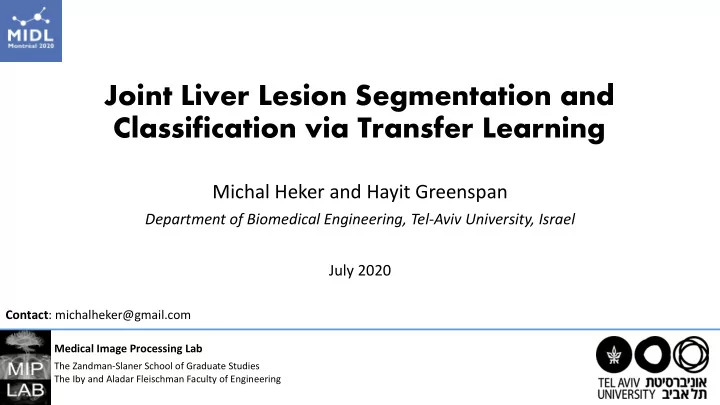

Joint Liver Lesion Segmentation and Classification via Transfer Learning Michal Heker and Hayit Greenspan Department of Biomedical Engineering, Tel-Aviv University, Israel July 2020 Contact : michalheker@gmail.com Medical Image Processing Lab The Zandman-Slaner School of Graduate Studies The Iby and Aladar Fleischman Faculty of Engineering
In Intr troduc ductio tion : Lesion segmentation & classification Lesion class § Liver lesion segmentation has attracted attention in recent years, with publicly available datasets that enable comparison between different methods. § In practice, it is also important to separate between malignant and benign lesions by classifying detected lesions. § Liver lesion classification is far less investigated with very limited-sized datasets explored and no public data available. Ø We focus on classification of liver CT images that include both benign and malignant lesions. Medical Image Processing Lab The Zandman-Slaner School of Graduate Studies The Iby and Aladar Fleischman Faculty of Engineering
In Intr troduc ductio tion : Main challenge § The lack of sufficient amounts of annotated data is one of the main challenges in the medical imaging domain. 1) Transfer learning 2) Joint learning Source task FC ImageNet Cat Segmentation CNN Dog … Transfer weights Target FC Probability map CT scans task Malignant/ CNN Benign § Adding an additional branch for classification results in improved § Transfer learning has been proven to have better performance when segmentation performance [2]. the tasks of the source and target network are similar [1]. [1] Mohammad Hesam Hesamian, Wenjing Jia, Xiangjian He, and Paul Kennedy. Deep learningtechniques for medical image [2] Mehta, Sachin, et al. "Y-Net: joint segmentation and classification for diagnosis of breast biopsy segmentation: Achievements and challenges.Journal of digitalimaging, 32(4):582–596, 2019 images." International Conference on Medical Image Computing and Computer Intervention . Springer, Cham, 2018. Medical Image Processing Lab The Zandman-Slaner School of Graduate Studies The Iby and Aladar Fleischman Faculty of Engineering
Da Data Sheba dataset 332 2D CT slices taken from 140 patients. § Annotations of : § - liver segmentation Metastasis Cyst Hemangioma - lesion segmentation - lesion classification into 3 classes: cyst, hemangioma, metastasis * Private dataset LiTS dataset (Liver Tumor Segmentation) 130 3D CT scans (~60,000 2D CT slices). § Annotations of: § - liver segmentation - lesion segmentation * Publicly available dataset Medical Image Processing Lab The Zandman-Slaner School of Graduate Studies The Iby and Aladar Fleischman Faculty of Engineering
Me Method ods : The proposed frameworks Multi-task Learning (Y-Net) Joint Learning 0 – BG 0 – BG 1 – liver ResNet Encoder/Decoder Block 1 – liver 2 – cyst SE Block 2- lesion 3 – hemangioma Bottleneck 4 – metastasis Fully Connected ℎ×𝑥×3 ℎ×𝑥×𝑑 ℎ×𝑥×3 ℎ×𝑥×𝑑 Segmentation output Segmentation + Classification 0 – cyst Classification output 1 – hemangioma 1×3 2- metastasis Ø We perform fine-tuning with different weights initialization: 1) Training from scratch (random initialization). 2) Fine-tuning with ImageNet weights 3) Fine-tuning with LiTS weights (self-trained lesion segmentation model). Same domain! Medical Image Processing Lab The Zandman-Slaner School of Graduate Studies The Iby and Aladar Fleischman Faculty of Engineering
Re Results & Conclusions Cyst Hemangioma Metastasis input Ground joint multi-task truth learning learning ü The simple joint framework outperforms the commonly used multi-task architecture ( 7%). ü Pretraind with LiTS better than imageNet ( 12%). Ø Joint network classification and localization context are shared for mutual benefit. Ø Pre-training the network with data from the same domain improves feature learning and generalization. Medical Image Processing Lab The Zandman-Slaner School of Graduate Studies The Iby and Aladar Fleischman Faculty of Engineering
Recommend
More recommend